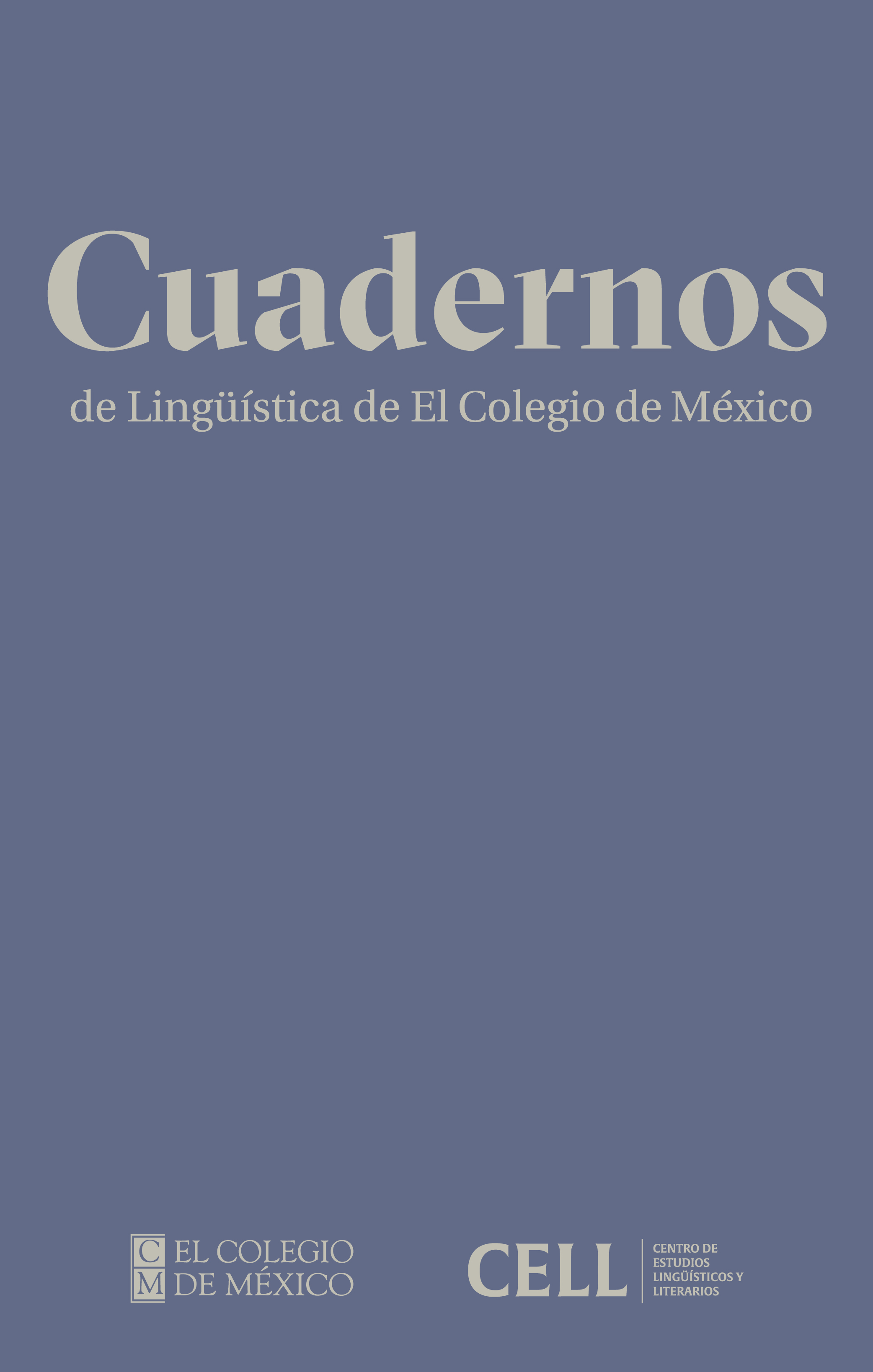System of reference in Wixárika
DOI:
https://doi.org/10.24201/clecm.v11i00.286Keywords:
reference system, discourse, grammaticalization, Wixárika, Uto-Aztecan, functional-typological approach, frequenciesAbstract
This research analyzes the system of reference in narratives from the Wixárika language. The language displays 8 strategies for identifying entities and their functions, 6 of which are common at a typological level, while the remaining two distinguish Wixárika from other Southern Uto-Aztecan languages. These two strategies include the suffixes of referential continuity and possessive pronouns which encode same or different subject. This research provides a detailed description of these resources, including their frequency and the process of grammaticalization of the suffixes of referential continuity. Overall, the language exhibits patterns that differ from those observed in previous literature.
Downloads
References
Broadwell, George Aaron. 1997. Binding theory and switch-reference. En Hans Bennis, Pierre Pica & Johann Rooryck (eds.), Atomism and binding, 31–49. Dordrecht: Foris. https://www.researchgate.net/publication/2691337_Binding_Theory_and_Switch-reference
Camacho, José. 2010. On case concord: The syntax of switch-reference clauses. Natural Language & Linguistic Theory 28. 239–274. https://doi.org/10.1007/s11049-010-9093-1 DOI: https://doi.org/10.1007/s11049-010-9093-1
Chomsky, Noam. 1981. Lectures on government and binding. Dordrecht: Foris. https://doi.org/10.1515/9783110884166 DOI: https://doi.org/10.1515/9783110884166
Comrie, Bernard. 1983. Switch-reference in Huichol: a typological study. En Haiman, John & Munro, Pamela (eds.). Switch-reference and universal grammar, 17-37. Ámsterdam/Philadelphia: Benjamins Publishing Company. https://doi.org/10.1075/tsl.2.03col DOI: https://doi.org/10.1075/tsl.2.04com
Comrie, Bernard. 1982. Grammatical relations in Huichol. En Hopper, Paul J. & Thompson, Sandra A. (eds.), Studies in transitivity, syntax and semantics 15, 95-115. Nueva York: Academic Press. https://doi.org/10.1163/9789004368903_007 DOI: https://doi.org/10.1163/9789004368903_007
Dakin, Karen. 2004. Prólogo. En Estrada Fernandez, Zarina, Buitimea Valenzuela, C., Gurrola Camacho, A. E., Castillo Celaya, M.E. & Carlón Flores, A. (eds.), Diccionario yaqui-español y textos. Obra de preservación lingüística, 13-20 México: Editorial Plaza y Valdés/Universidad de Sonora.
Dooley, Robert & Levinsohn, Stephen H. . 2001. Analyzing discourse: a manual of basic concepts. Dallas, TX: SIL International. https://www.sil.org/resources/archives/3547
Finer, Daniel L. 1984. The formal grammar of switch-reference. University of Massachusetts. Amherst. (Tesis de doctorado). https://searchworks.stanford.edu/view/1549670
Finer, Daniel L. 1985. The Syntax of Switch-Reference. Linguistic Inquiry, 16(1). 35–55.
Foley, William & Van Valin, Robert. 1984. Functional Syntax and Universal Grammar. Cambridge: Cambridge University Press.
Frajzyngier, Zygmunt. 2018. Information structure and reference systems: Toward a non-aprioristic typology. En Reading Fernandez-Vest & Van Valin, Foley 2016. Journal of Language Contact, 11. 139-165. https://doi.org/10.1163/19552629-01101005 DOI: https://doi.org/10.1163/19552629-01101005
Georgi, Doreen. 2012: A uniform analysis of global and local argument encoding patterns: A local and cyclic approach. En Constantinescu, Cristian, Le Bruyn, Bert & Linke K (eds.), Proceedings of ConSOLE XVII (2009, NOva Gorica). 137-161. http://www.doreengeorgi.com/papers.html
Givón, Talmy. 1983. Topic continuity in discourse. Ámsterdam: John Benjamins Publishing Company. https://doi.org/10.1075/tsl.3 DOI: https://doi.org/10.1075/tsl.3
Givón, Talmy. 1992. The grammar of referential coherence as mental processing instructions. Linguistics, 30(1). 5–55.https://doi.org/10.1515/ling.1992.30.1.5 DOI: https://doi.org/10.1515/ling.1992.30.1.5
Givón, Talmy. 2001. Syntax I. A functional typological introduction. Ámsterdam: John Benjamins Publishing Company. https://doi.org/10.1075/z.syn1 DOI: https://doi.org/10.1075/z.syn1
Givón, Talmy. 2005. Context as Other Minds: The Pragmatics of Sociality, Cognition and Communication. John Benjamins Publishing Company. https://doi.org/10.1075/z.130 DOI: https://doi.org/10.1075/z.130
Gómez López, Paula. 1999. Huichol de San Andrés Cohamiata, Jalisco. México: El Colegio de México. https://libros.colmex.mx/tienda/huichol-de-san-andres-cohamiata-jalisco/
Gómez López, Paula & Ortiz López, Angélica. 2004. El desarrollo de la competencia narrativa en niños huicholes. Lenguas y Literaturas Indígenas de Jalisco, 255-280. Guadalajara, Jalisco: Secretaría de Cultura, Gobierno del Estado de Jalisco. https://sc.jalisco.gob.mx/sites/sc.jalisco.gob.mx/files/04lenglitind.pdf
Gómez López, Paula. 2009. La adquisición de la expresión espacial en wixárika (huichol). Función. 31-32.
Grimes, Joseph E. 1964. Huichol Syntax. Londres: De Gruyter Mouton.
Grimes, Joseph E. 1981. El Huichol: Apuntes sobre el léxico. Departamento de Lenguas Modernas y Lingüística. Nueva York: Cornell University. https://mexico.sil.org/resources/archives/1262
Guerrero Valenzuela, Lilián, Belloro, Valeria A. & Conti Jiménez, Carmen. 2012. Rasgos prominentes en la clasificación nominal en lenguas yutoaztecas: la particularidad del wixárika. En Conti Jiménez, Carmen, Guerrero Valenzuela, Lilián & Santos García, Saúl (eds.), Aproximaciones a la documentación lingüística del huichol, 183-212. España. Universidad de Jaén. https://www.academia.edu/2391525/2012_Guerrero_Belloro_Conti_2012_Rasgos_prominentes_en_la_clasificaci%C3%B3n_nominal_en_lenguas_yutoaztecas_la_particularidad_del_wix%C3%A1rika1rika
Guerrero Valenzuela, Lilián. 2019. Supleción en yaqui y wixárika (dossier). Lingüística Mexicana 1(2). 119-140. https://linguisticamexicanaamla.colmex.mx/index.php/Linguistica_mexicana/article/view/330 DOI: https://doi.org/10.62190/amla.lmne.2019.1.2.7
Gundel, Jeanette y Hedberg, Nancy. 2016. Reference and Cognitive Status: Scalar Inference and Typology. En Fernandez-Vest Jocelyne M.M. & Van Valin Robert D. (eds.), Information structuring of spoken language from a cross-linguistic perspective, 33–53. Berlín: De Gruyter Mouton. https://doi.org/10.1515/9783110368758-003 DOI: https://doi.org/10.1515/9783110368758-003
Haiman, John, & Pamela Munro. 1983. Introduction. En Haiman, John & Munro, Pamela (eds.), Switch-reference and universal grammar, ix–xv. Ámsterdam: John Benjamins. https://doi.org/10.1075/tsl.2 DOI: https://doi.org/10.1075/tsl.2
Halliday, Michael Alexander Kirwood. 1976. Halliday: System and Function in Language: Selected Papers. Londres: Oxford University Press. https://archive.org/details/hallidaysystemfu0000hall/page/n5/mode/2up
Heath, Jeffrey. 1983. Referential tracking in Nunggubuyu (Australia). En Haiman, John & Munro, Pamela (eds.), Proceedings of a symposium on switch reference and universal grammar, Winnipeg, May 1981, 129-149. https://doi.org/10.1075/tsl.2.09hea DOI: https://doi.org/10.1075/tsl.2.09hea
Iturrioz Leza, José Luis. 1987. Individuación en huichol III. Función 2(1). 154-163. http://148.202.18.157/sitios/publicacionesite/pperiod/funcion/pdf/4/154.pdf
Iturrioz Leza, José Luis & Gómez López, Paula. 2006. Gramática Wixárika. Múnich: Lincom.
Jacobsen, William. 1967. Switch-reference in Hokan-Coahuiltecan. En Hymes, Dells & Bittle, William (eds.), Studies in southwestern ethnolinguistics, 238–263. La Haya: Mouton.
Keine, Stefan. 2013. Deconstructing switch-reference. Natural Language & Linguistic Theory, 31. 767-826. DOI: https://doi.org/10.1007/s11049-013-9194-8
Kibrik, Andrej. 2009. Basics of referential systems: Sorting things out. Proceedings of the 7th Discourse Anaphora and Anaphor Resolution Colloquium (DAARC 2009).
Kibrik, Andrej. 2011. Reference in discourse. Oxford: Oxford University Press. https://doi.org/10.1093/acprof:oso/9780199215805.001.0001 DOI: https://doi.org/10.1093/acprof:oso/9780199215805.001.0001
Kibrik, Andrej. 2013. Peculiarities and origins of the Russian referential system. En Dik, Bakker & Haspelmath, Martin (eds.), Languages across boundaries. Studies in Memory of Anna Siewierska, 227-262. Berlin: De Gruyter Mouton. DOI: https://doi.org/10.1515/9783110331127.227
Munro, Pamela. 1980. Studies of Switch-Reference, UCLA Papers in Syntax (8) Department of Linguistics, UCLA, Los Angeles, California. https://www.sil.org/resources/archives/2801
Nichols, Johanna. 1983. Switch-reference in the Northeast Caucasus. En Haiman, John & Munro, Pamela (eds.), Switch-reference and universal grammar, 245–265. Ámsterdam: John Benjamins. https://doi.org/10.1075/tsl.2.14nic DOI: https://doi.org/10.1075/tsl.2.14nic
Palafox Vargas, Miguel. 1978. La llave del Huichol. México: Instituto Nacional de Antropología.
Ramos Bierge, Stefanie. 2017. Clause types and transitivity in Wixárika (Huichol): A Uto-Aztecan language. University of Colorado at Boulder. (Tesis de doctorado.) https://scholar.colorado.edu/concern/graduate_thesis_or_dissertations/1n79h429p
Ramos Bierge, Stefanie & Félix López, Norma Lucía. 2018. El origen de la mujer: Un relato de la cosmogonía Huichol (Wixárika). En Guerrero Valenzuela, Lilián & Montes de Oca, Liliana (eds.), Tlalocan 21. 75-132. https://doi.org/10.19130/iifl.tlalocan.2018.477 DOI: https://doi.org/10.19130/iifl.tlalocan.2018.477
Ramos Bierge, Stefanie. 2019a. Valency-increasing suffixes in Huichol: The overlap of functions. En Estrada Fernández, Zarina; Tubino, Mercedes & Álvarez Gonzalez, Albert (eds.), Estudios en lenguas amerindias 4: Escenario actual de investigación sobre lenguas yutoaztecas. Homenaje a Jane H. Hill, 306-336. Hermosillo: Universidad de Sonora. https://www.stefrb.com/publications
Ramos Bierge, Stefanie. 2019b. Las posposiciones y elementos de su tipo en huichol: Rasgos estructurales y funcionales. En Guerrero, Lilián (ed.). Adposiciones y elementos de su tipo en lenguas amerindias, 439-476. Ciudad de México: Universidad Nacional Autónoma de México. https://www.stefrb.com/publications
Watanabe, Akira. 2000. Feature copying and binding: Evidence from complementizer agreement and switch reference. Syntax 3. 159–181. https://doi.org/10.1111/1467-9612.00031 DOI: https://doi.org/10.1111/1467-9612.00031
Published
How to Cite
-
Abstract570
-
PDF (Español)208
-
XML (Español)46
-
EPUB (Español)65
-
Kindle (Español)211
-
MP3 (Español)8
Issue
Section
License
Copyright (c) 2024 Stefanie Ramos Bierge

This work is licensed under a Creative Commons Attribution-NonCommercial-NoDerivatives 4.0 International License.
Authors retain copyright of their work and are free to disseminate it, make copies for any use, and/or deposit in any repository or archive of their choice, but they grant Cuadernos de Lingüística de El Colegio de México the right to publish the work for the first time. Authors agree to acknowledge Cuadernos de Lingüística de El Colegio de México as the site of original publication of their article / note / review through proper citation.
Articles appearing in Cuadernos de Lingüística de El Colegio de México are made available to readers under a Attribution-NonCommercial-NoDerivatives 4.0 International.









